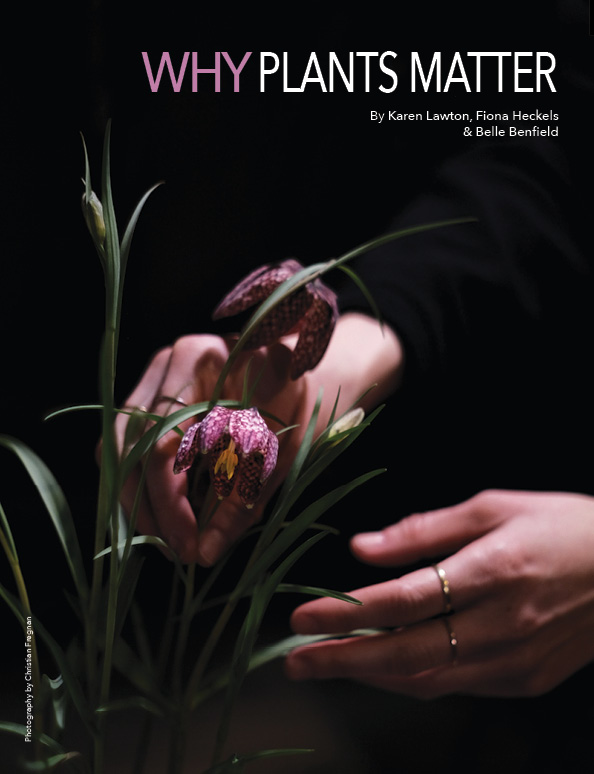By Karen Lawton, Fiona Heckles & Bella Benfield
Humans and plants have evolved together. This is demonstrated by the interaction of plant compounds with receptors in the human body, compounds that can be almost identical to hormones or neurotransmitters. We are in essence made of the same stuff.
Plants and people have lived together side by side from the very beginning. We share a rich, colourful history. We are intertwined.
There are around 300,000 plant species on our planet. They are the only life forms that can produce their own energy source from sunlight. Through photosynthesis and transpiration, they create an environment suitable for us and other animals to live in, regulating our planet’s water and air supply.
Herbal medicine is an art and, in more modern times, a science. Plant healing has ensured our survival, allowing us to cure ourselves and thrive as a species. Every community has utilized its native plants for medicine. According to the World Health Organization, 80 percent of people in Africa still rely on traditional herbal medicines as their main healthcare, often conducted with a sacred connection to the plants.
How did our ancestors discover the medicinal potential of plants? We can only speculate. Most likely they observed the plant and animal kingdoms, and used their instinct to discover the wonderful healing qualities of plants, knowledge that was then passed down through the generations. It’s fascinating to observe this inherent knowledge in animals. Horses will self-medicate when they’re sick, naturally foraging for nettles if given access to them. These nettles can provide a horse with essential minerals, can help reduce the inflammation of laminitis, treat kidney complaints, help with allergies and support lactation issues, among other ailments. Similarly, a horse will naturally avoid ragwort if there are plenty of other food sources (a yellow-flowering plant in the daisy family, ragwort commonly grows in fields but is toxic to horses).
Food
Almost everything that we ingest comes directly or indirectly from plants. Throughout human history approximately 7,000 different plant species have been used as food. Wheat is thought to have been the first plant cultivated, in the Middle East c. 8000 BCE.
Clothing
Cotton, flax, hemp, nettle and bamboo are among the plants generously giving us their harvest to make fabrics. The use of plastics in fabrics is contributing to our current environmental crisis; when washed, these fabrics shed plastic microfibres into the water system. We need ecologically friendly fabrics – the awesomely strong fibre of stinging nettles is an excellent choice. Nettles have hollow fibres that are filled with air, creating natural insulation. In fact the use of nettles in clothing dates back some two millennia; it was only with the arrival of cotton in the 16th century that this useful plant fell from favour. In World War I, when cotton ran short in Germany, nettles were used to make army uniforms.
Medicine and Ritual
Plants have long been used for medicinal purposes. Ancient Chinese and Egyptian papyrus writings describe medicinal uses for plants as early as 3000 bce. In cultures where practices have remained relatively unchanged for millennia, herbs are still used in healing rituals. Traditional medical systems that involve prolific use of herbs, such as Ayurveda in India and Traditional Chinese Medicine, are so embedded in the culture of their country that they are still part of more mainstream medicine today, with herbs
administered within hospital systems.
In many places across the globe, there is fantastic diversity in native and naturalized plants and a rich ancestral history of plant medicine that is still being uncovered. Herbal medicine has evolved over time with crosspollination between many cultures. Scientific models are now being applied to some of the oldest texts available. For example, research has been carried out on the recipes and herbal actions in the Leech Book of Bald, written in Saxon times. Science is confirming the wisdom that has been known for centuries.
Animism – the belief that there is God or spirit in all things – can be found in many ancient Earth-based wisdom traditions. Each plant has its own sacred spirit, which makes it more than just its physical substance. This is synergy, meaning the combined effect of the parts is greater than the sum of the separate parts. It indicates that when compounds work together their effects are enhanced. This sacred or ethereal aspect has been utilized in rituals for purification, consecration, protection and community cohesion.
When altering consciousness for religious ceremonies, art and personal exploration, humans have used psychotropic plants and fungi to celebrate and connect with spirit for millennia. There are theories that the religious experience was initiated in humans originally through mushroom intoxication. Could it even be that psychedelic experiences played a part in the evolution of the human brain?
Paper
From the Bible to Harry Potter, literature is filled with references to our plant allies. The very paper on which books are printed comes from the plants, too. The word “paper” derives from the Latin papyrus, which is the name for a plant once abundant in Egypt and used by the ancient Egyptians, Greeks and Romans to produce a thick sheet-like material for writing and painting.
Folklore
A multitude of stories have been told about the folklore of plants, their characters and spirits. Several botanical names of plants derive from Greek and Roman myths. For example, the Roman goddess Diana was the huntress. In Greek, her name is Artemis, the moon goddess, and many species of plants with her namesake, Artemisia, cast a silvery moon-glow from their leaves. The protector of small children, she helped her mother to birth her twin brother Apollo immediately after she had been born. Artemisia species such as mugwort are used in labour to help bring down the baby. There is a long tradition in Chinese medicine of using Moxa sticks, which contain charcoal and mugwort, during and just before the birth process. Mugwort stimulates oxytocin, the hormone that is released during birth (and also in orgasm). Yarrow, or Achillea millefolium, is named after Achilles the warrior. It is said that Achilles used the plant to staunch the wounds of his fellow soldiers, and indeed it is known as a styptic, staunching the flow of blood.
Disconnection
People have always lived interdependently with plants and yet we no longer value them, no longer treat them as sacred. Mass agriculture has changed our outlook. Our wild spaces are getting smaller and smaller. We are still hugely dependent on plants but we no longer recognize this. Now the corporations are chemical producers and we are the lab rats. As herbalists, we see untold damage done to many people by prescription medications. Drugs have side effects. What’s the solution? Take another pill. This reliance on pharmaceutical drugs plays a big part in the ill-health of our planet and our physical, emotional and spiritual disconnection from the plant world around us.
People in much of the Western world have lost touch with the medicine of the Earth, and have consequently forgotten how to care for her. Herbalism is a nearly forgotten art in many places, seen as antiquated “folk” or “old wives’” medicine. The skills of our great-grandparents to treat simple complaints are no longer deemed relevant and much of the herbal knowledge of the past has died out.
Moving Forward
Access to herbal medicine and information is vital if we are to shift toward a more responsible society. It’s often forgotten that we have the power as individuals to make choices. Getting to know how our bodies work, and making changes for our emotional and spiritual wellbeing, promotes happier, healthier societies. Connecting people to plants strengthens the bonds of protection and love for Mother Earth.
There are many benefits to modern allopathic medicine, but also costs in terms of wellbeing and finance. Today, individual plant compounds are extracted, then refined for use as allopathic drugs to treat particular conditions. While this has certainly led to faster treatment of certain conditions, these drugs also have side effects. A whole plant containing a multitude of chemical constituents has a very different action on the physical body, because all those phytochemicals work synergistically. For example, the herb meadowsweet contains the compound salicylic acid, the constituent that aspirin is derived from. Aspirin’s side effects include corroding the stomach lining and causing ulcers. Conversely, meadowsweet is actually indicated for stomach ulcers in herbal medicine, because of other constituents that it contains in addition to salicylic acid, all working in synergy.
Today, laws specify that some plants are illegal to grow and possess. Others are seen as colossal cash crops to be taxed and exploited. Governments dictate how we can and cannot distribute herbal medicines, yet often these governments themselves have little knowledge about plant medicine.
Herbal medicine, in contrast, is alchemy, the creative power to transform a plant into a potion for positive change. Traditional pharmacy taught that herbal preparations should be presented in a beautiful way, and this was part of the healing. And right up until the middle of the 20th century, the presentation and packaging of all medicine was indeed beautiful. Have you ever seen old glass medicine bottles? They are usually made from hand-blown, coloured glass, decorated with patterns and logos. Presenting the medicine attractively honours the life force of the plant and draws the recipient toward a cure. Belief in the medicine and appreciation of its beauty inspires healing.
The core intention of Sensory Herbalism is to encourage as many folks as possible to connect with the Earth, to protect her from greed and violence and place the power of plant medicine back where it belongs, in the hands of the people.
Our Earth needs as many secret heroes as possible. Knowledge about the plant world and its medicinal powers makes secret heroes of us all, working together toward a better future.
We are committed to developing projects that will spread through all parts of society, in order to achieve a massive shift in consciousness, toward thinking more holistically about health, wellbeing, education and community. Thankfully, today people are becoming interested in herbal medicine again. They are taking notice of the green spaces around them and wondering what marvels these can offer in terms of food and herbal medicines. Our children should be brought up with knowledge about the medicinal plants that grow around them, and learn to cultivate and nurture them in order to make simple herbal preparations. We hope this book will inspire people to work with plants in a creative way – that it will inspire greater self-awareness and a desire for knowledge that can be passed down to the teachers of the future, our children.







